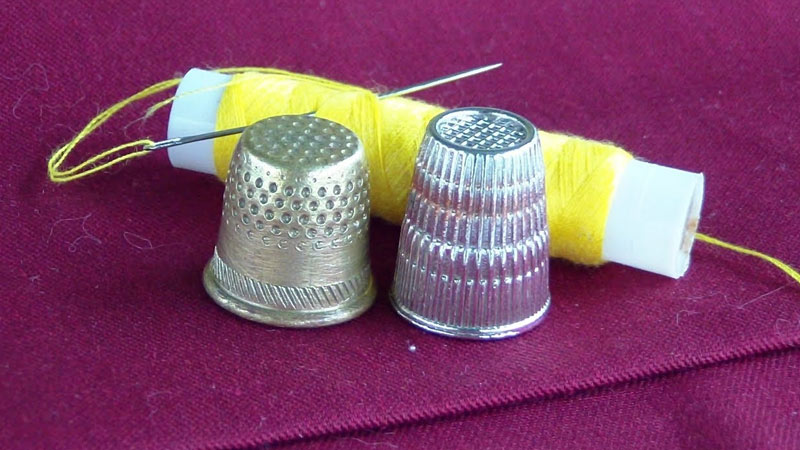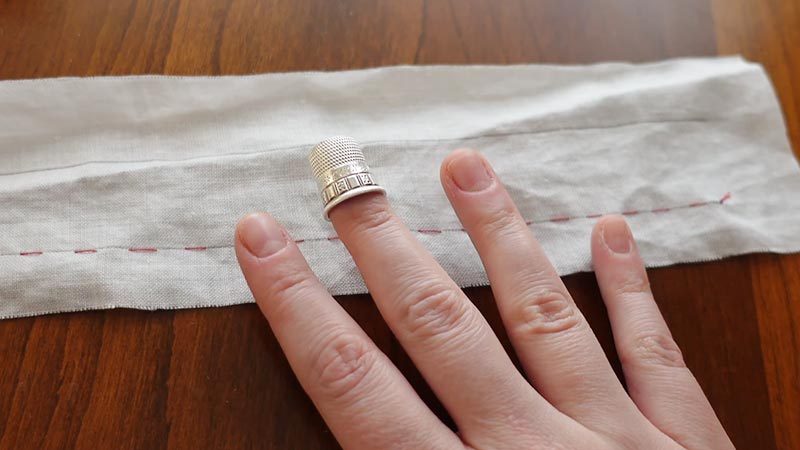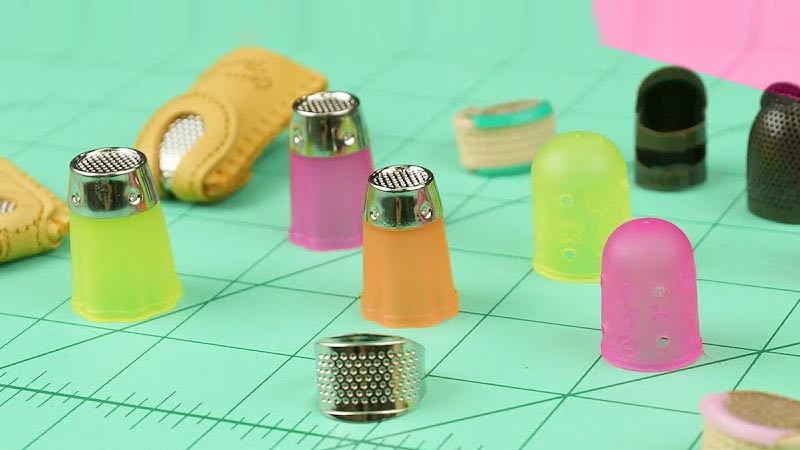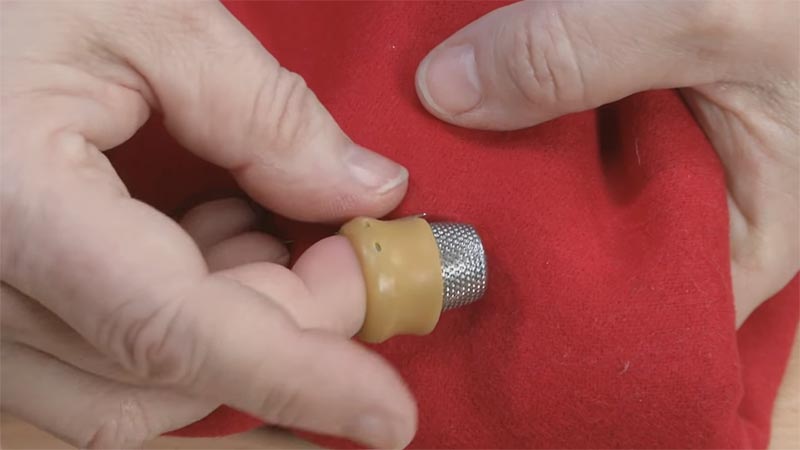In the world of sewing, where creativity meets craftsmanship, every tool has its unique role. A humble and often underestimated tool, the thimble, holds a special place in the heart of every sewer.
This unassuming accessory, typically a small cap made of metal or plastic, may seem inconspicuous, but its significance is immeasurable. The thimble is a silent protector, a guide, and a friend to those who stitch by hand.
It shields fingers from the pricks of sharp needles and ensures precise control, especially when working with stubborn fabrics. In this exploration, we delve into the multifaceted world of thimbles, uncovering the essential role they play in the art of sewing.

What Is Thimble in Sewing?
A thimble in sewing is a small, protective device worn on the fingertip. Its primary purpose is to shield the finger from sharp sewing needles, preventing pricks and injuries.
Thimbles often feature a textured or dimpled surface, which aids in needle control, making it easier to guide the needle through the fabric and maintain even stitching.
They enhance the speed and precision of hand sewing, reduce finger fatigue, and provide comfort during extended sewing sessions.
Thimbles come in various materials and sizes, catering to individual preferences and sewing needs, making them an essential tool for sewers of all levels of expertise.
What is a Thimble Used for in Sewing?

A thimble is a small but essential tool in the world of sewing. Its primary purpose is to protect the finger that pushes the needle through the fabric during hand sewing. Thimbles are typically made of metal, plastic, leather, or silicone and come in various sizes and designs.
Here’s what a thimble is used for in sewing:
Finger Protection
Thimbles shield your fingertips from the sharp, pointed needles used in sewing. They act as a protective barrier, preventing accidental needle pricks and injuries, especially when dealing with heavy or multiple layers of fabric.
Needle Control
Thimbles are typically designed with a textured or dimpled surface, providing better grip and control over the needle. This makes it easier to push the needle through the fabric, guiding it precisely where needed.
Enhanced Precision
Thimbles allow for more precise and accurate hand sewing. Whether you’re working on intricate embroidery or basic stitching, a thimble helps maintain consistent stitch length and tension.
Comfort and Endurance
Extended periods of hand sewing can lead to finger fatigue and discomfort. Thimbles offer a cushioned surface for your finger, reducing strain and the risk of blisters. They enable you to sew for longer durations without discomfort.
Versatility
Thimbles come in various materials and designs to cater to individual preferences. Whether you prefer a traditional metal thimble, a flexible leather thimble, or a modern silicone thimble, there’s a choice for everyone.
How Can You Select the Perfect Thimble for Your Sewing Needs?

Selecting the perfect thimble for your sewing needs is an important step in ensuring comfortable and precise hand stitching. Thimbles come in various styles and materials, each designed for specific purposes.
Here’s a guide on how to choose the ideal thimble for your sewing projects:
Determine Your Finger Size
Measure the finger on which you plan to wear the thimble. Thimbles come in various sizes, so it’s essential to choose one that fits comfortably without being too loose or too tight.
Consider Your Sewing Style
Think about the type of sewing projects you typically undertake. Different thimbles are designed for specific sewing techniques and materials.
For example:
- Metal Thimbles: These are versatile and suitable for general sewing. They are great for tasks like mending, hemming, and basic stitching.
- Leather Thimbles: Ideal for heavy fabrics like denim or leather, as they offer protection and control when dealing with thicker materials.
- Silicone or Rubber Thimbles: These are gentle on delicate fabrics and are excellent for fine embroidery or sewing intricate designs.
Consider Material and Comfort
Thimbles come in various materials, including metal, leather, silicone, plastic, and more. Consider which material feels most comfortable on your finger. Some sewers prefer the classic feel of a metal thimble, while others opt for the flexibility and comfort of silicone.
Try Before You Buy
If possible, try on different thimbles to determine which one offers the best fit and comfort. You can visit a sewing or craft store to test out different options. Keep in mind that your finger may change size due to factors like temperature, so choose a thimble that accommodates variations.
Test for Grip and Control
Pay attention to the texture and grip of the thimble’s surface. A textured or dimpled thimble can provide better control when pushing the needle through the fabric. Ensure that the thimble you choose allows you to securely grip and guide the needle.
Read Reviews and Seek Recommendations
Before making a purchase, read reviews or seek recommendations from fellow sewers or online sewing communities. This can provide insights into the performance and durability of different thimbles.
Consider Eco-Friendly Options
If you’re environmentally conscious, look for thimbles made from sustainable or recycled materials, such as bamboo or recycled plastics.
Evaluate Price and Durability
Thimbles come in a range of price points. Consider your budget and balance it with the durability and longevity of the thimble. A high-quality thimble may be a wise investment for long-term use.
Tips for Using Thimbles in Sewing

Using thimbles in sewing can make your hand stitching more efficient and comfortable. Whether you’re a beginner or an experienced sewer, here are some valuable tips for effectively using thimbles in your sewing projects:
Choose the Right Size
Thimbles come in various sizes to fit different finger dimensions. It’s crucial to select one that fits snugly on the finger you plan to use it on. A well-fitted thimble will provide better control and protection.
Wear it Correctly
Place the thimble on the middle finger of your dominant hand. Ensure it’s snug but not too tight, allowing for comfortable movement and precise needle control.
Practice and Familiarize Yourself
If you’re new to using a thimble, spend some time practicing its usage on scrap fabric before tackling your main sewing project. This will help you get accustomed to the tool’s feel and functionality.
Utilize the Thimble Texture
Many thimbles feature a dimpled or textured surface. Use this texture to your advantage by gripping the needle securely and guiding it through the fabric with precision.
Hold the Needle Properly
When using a thimble, hold the needle between your thumb and index finger. The thimble on your middle finger allows you to push the needle through the fabric while maintaining control.
Select the Right Thimble for the Task
Different thimbles are suited for various sewing techniques and materials. For instance, a leather thimble might be ideal for heavy fabrics, while a silicone thimble could be perfect for delicate work. Choose the thimble that best suits your project.
Stabilize the Fabric
To make stitching more manageable, place your other hand beneath the fabric you’re sewing. This added support can make it easier to guide the needle through the fabric.
Adjust Thimble Fit as Needed
If your thimble becomes uncomfortable during extended sewing sessions or if you experience finger fatigue, consider adjusting the fit or switching to a different thimble type that better suits your needs.
Take Breaks
Sewing for long periods can be taxing on your fingers. Remember to take short breaks to rest your fingers and prevent strain.
Maintain and Clean Your Thimble
Regularly clean your thimble to remove oils and debris that may accumulate from sewing. For metal thimbles, prevent rust by drying them thoroughly after cleaning.
Experiment with Different Techniques
There are various ways to use a thimble. Experiment with different techniques to find the one that works best for you and your sewing style.
Safety First
While thimbles offer protection, it’s important to remain cautious when handling needles. Always handle needles with care to prevent accidents, and be mindful of your hand movements.
FAQs
What materials are thimbles made from, and how do they differ?
Thimbles are made from materials like metal, leather, silicone, plastic, and more. Material choice affects comfort, durability, and suitability for specific sewing tasks.
Do thimbles come in different sizes?
Yes, thimbles are available in various sizes to ensure a snug fit. It’s important to choose a thimble that fits comfortably on your finger for effective use.
Are thimbles essential for all types of sewing?
No, thimbles are not essential for all types of sewing, but they can be highly beneficial for enhancing precision and finger protection in various sewing styles.
Can I use a thimble for machine sewing, or are they primarily for hand sewing?
Thimbles are primarily designed for hand sewing, but they can also be used for machine sewing to provide extra protection when guiding fabric through the machine.
What should I do if my thimble doesn’t fit properly on my finger?
If your thimble is too loose, you can add padding or use a thimble adjuster to make it fit better. If it’s too tight, you may need to try a larger size or opt for a different type of thimble.
To Recap
In the intricate tapestry of sewing, the thimble is a small yet indispensable thread. It stands as a sentinel against needle pricks and a steadfast companion in guiding stitches.
As we conclude this journey into the world of thimbles, we are reminded of their multifaceted significance in sewing. These unassuming tools, with their textured surfaces, protective barriers, and comfortable fits, transform the sewing experience.
They elevate precision, enhance comfort, and enable the creation of beautifully crafted garments, quilts, and intricate embroidery.
Thimbles are not mere accessories; they are the unsung heroes that stand between a sewer and the artistry they seek to bring to life, adding both practicality and artistry to every stitch.
Leave a Reply